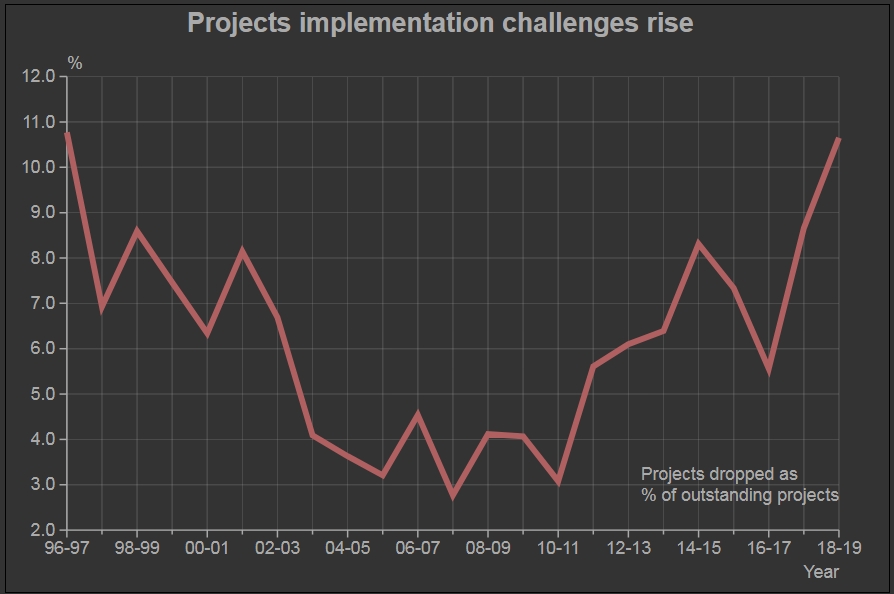 CMIE’s CapEx database shows a sharp fall in new investment proposals since 2014-15. New investment proposals had peaked at Rs.26.7 trillion in 2008-09. After the global financial crisis of 2008-09 and the domestic supply bottlenecks of coal, gas, iron ore and even land, new investment proposals fell to Rs.10.3 trillion in 2013-14. They recovered smartly in 2014-15, but quickly fell back to Rs.10 trillion in 2018-19.
CMIE’s CapEx database shows a sharp fall in new investment proposals since 2014-15. New investment proposals had peaked at Rs.26.7 trillion in 2008-09. After the global financial crisis of 2008-09 and the domestic supply bottlenecks of coal, gas, iron ore and even land, new investment proposals fell to Rs.10.3 trillion in 2013-14. They recovered smartly in 2014-15, but quickly fell back to Rs.10 trillion in 2018-19.
The fall in new investment proposals during 2017-18 and 2018-19 are not because of any global crisis or domestic supply bottlenecks as seen during 2011-12 through 2013-14. Yet, new investment proposals have slowed down.
There is also a slowing down of implementation of the projects.
The best measure of implementation of projects is seen in the completion of investment projects. This has increased in recent years. It peaked at Rs.6.5 trillion in 2016-17. Then, completions climbed down to Rs.5 trillion in 2017-18 and Rs.6 trillion in 2018-19.
This slowing down of project completions is intriguing. The stock of projects announced in the past and even those whose implementation made some progress has been rising. Scheduled completions, as announced by promoting or implementing companies are usually of the order of Rs.12-13 trillion per year. But, every year, companies fail to complete projects as per their own projections.
In 2017-18, projects worth Rs.12.6 trillion were expected to be completed as per our understanding, which was largely based on company projections. By the end of the year, projects worth only Rs.5 trillion were completed. The completion to expectation ratio was 38.5 percent. In 2018-19, projects worth Rs.6 trillion were completed against an expectation of Rs.13.1 trillion. The ratio was slightly better at 46 percent.
This fall in project completions in the past two years notwithstanding, investment completions since 2014-15 have been much higher, with an average of Rs.5.5 trillion a year compared to earlier periods when completions were much lower than Rs.4 trillion a year.
While the absolute values look good compared to the past, the same cannot be said of the relative measures of project completions.
Given the massive build-up of project proposals over time, the stock of projects that can be converted into new capacities is high. The value of total projects under implementation as of March 2014 was Rs.88 trillion. This rose to Rs.110 trillion by March 2019.
A very small proportion of this stock gets converted into new capacity in a year. In 2018-19, only 5.4 percent of the stock at the beginning of the year was converted into completed new capacities during the year. This conversion ratio had been falling steadily from 7.7 percent in 2006-07 to 4 percent in 2013-14. The ratio then improved in the following three years to reach 6.2 percent in 2016-17 but has since slipped back to 5.4 percent in 2018-19.
While the rate of completion has therefore slowed down, an increasing proportion of the stock of projects are being abandoned.
In 2018-19, 10.7 percent of all projects outstanding were abandoned, shelved, stalled or had to be removed because of no trace of information on them for several years. In the previous year, 8.7 percent of the projects had to be similarly removed. These are record ratios.
Evidently, new project announcements have slowed down, the rate of completion of projects has slowed down and the rate of abandoning of projects has increased.
As of early June 2019, the CapEx database indicates that projects worth Rs.12.9 trillion should get completed in 2019-20. Past records have shown that such expectations are usually belied by a huge margin.
However, a distinct turnaround in new project announcements and also in project completions was seen after a new government had taken over in May 2014. That was Modi 1.0. The spurt, however, fizzled out too soon.
In May 2019, Modi 2.0 took charge. A new government is usually inclined to take bold decisions in its initial days. We will monitor projects to see if a turnaround in investments happens sooner than later.

Source: CMIE










